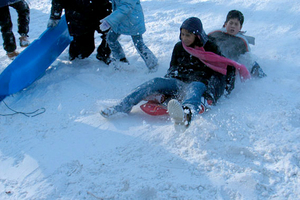For kids growing up in a cold climate, one of the highlights of winter is snow sledding down a hill, experiencing the thrill of the speed and the knowledge that it’s just dangerous enough to make their parents nervous.
Choosing the best snow sled depends on a number of factors, including the age and size of the person(s) who will be using it, price, and design and aesthetic preferences, among others.
There is a wide variety of types of snow sleds available, so the first thing you need to do is familiarize yourself with these types and decide which best fits your needs. This could mean talking to families that own sleds, going to stores so you can physically examine the options, or doing further online research.
For example, sleds can be foam, metal, plastic, or wood. There are even inflatable snow tubes that can be used as snow sleds but also can be used as floaters in the water in warmer months.
Flat board sleds are the most common. Usually rectangular, there are also some that are disc-shaped. Longer ones can seat multiple riders. Some have a pivoting front and can be steered.
Luge-type sleds are on runners or skis, and are typically heavier and steerable.
There are also more unorthodox designs, such as sleds with seats that a person sits upright in and handlebars to steer, sort of like being on a bicycle atop a sled.
You can go to Craigslist or eBay and pick up a used snow sled for $10 or $20. You can also pay many hundreds of dollars for a souped up sled primarily for adults that can carry 300 pounds or more.
For example, starting at the inexpensive end, the Snopedo Snow Bodyboard is a small, inflatable, one-person sled, 43 inches by 20 inches when inflated. It has molded PVC handles, heat-sealed seams, and an additive that is supposed to prevent cracking at even well below zero temperatures. It sells for under $20.
The Airhead Snow Toboggan is another inflatable. Measuring 69 inches by 26 inches, it can comfortably be used by two children. It has plastic runners on the bottom, and the same welded seams and additive to prevent cracking in the cold as the aforementioned Snopedo. It sells for $40-$50.
The Slicer All-Season Sled is a polyethylene plastic sled with a contoured, double-walled construction, 38 inches by 20 inches. It functions like a normal snow sled on snow, but what is unique about its design is that it comes with detachable pieces that can be filled with water, frozen into ice blocks, and then attached to the bottom of the sled. That makes it slippery enough to duplicate the sledding experience in any weather, even in the middle of summer. It sells for under $100.
The Bambino Grande Pull Sled is a classic wooden sled, with a molded bottom of slippery plastic. Measuring 34 inches by 14 inches, it has handrails and comes with a rope for pulling. Recommended for young children. It sells for about $140-$150.
The Snow Blazer Sled, 46 inches by 18 inches, is a high tech plastic sled with wide runners, an upright tractor seat, a steering wheel, and brakes. It is recommended for older children. It sells for over $200.
Whichever snow sled you choose, you should always be conscious of safety. Get a sled that is the right size and is age appropriate.
Sources:
Angela Brown, “Snow Sleds for Kids and Families.” About.com.
Yuen Kit Mun, “How to Choose the Best Snow Sled, Luge, Toboggan.” Suite 101.
“Reviews of the Best Snow Sleds and Toboggans.” Galt.
“Snow Sleds-From Narly to Nostalgia!” Snowsleds.

